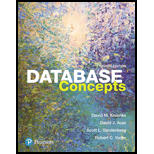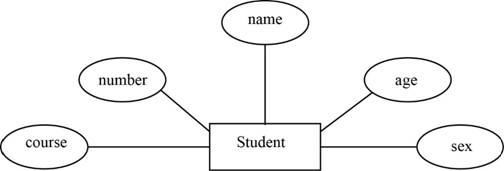
Concept explainers
Explain how entities are transformed into tables.
Explanation of Solution
Entity:
An entity is an object that the user wants to model and store the information about an object.
- Entity normally recognizable concepts such as things, place, person, unit or any item relevance to the database.
- Employee, Lecturer, Student are some of the examples of entities.
Table:
Table is a collection of associated data, consists of rows and columns.
- These data are arranged in a structured layout within a database.
Steps for transforming entities into table:
- In the start a table for each entity is created and the name is given to that entity.
- Specify the primary key for that table.
- Columns has to created in relation for each and every attribute present in the entity.
- In the final step, normalize the table.
Example:
Consider the example of transforming entity into table is as follows:
Entity:

Table:

Explanation:
In the above entity diagram, the “Student” is the entity and “number”, “name”, “age”, “sex”, and “course” are the attributes of that entity.
In the above table, “number” acts as the primary key for the “Student” table. Finally normalize the data in the table.
Want to see more full solutions like this?
Chapter 5 Solutions
Database Concepts (8th Edition)
Additional Engineering Textbook Solutions
Elementary Surveying: An Introduction To Geomatics (15th Edition)
Modern Database Management
Mechanics of Materials (10th Edition)
Starting Out with Java: From Control Structures through Objects (7th Edition) (What's New in Computer Science)
Starting Out with Programming Logic and Design (5th Edition) (What's New in Computer Science)
Web Development and Design Foundations with HTML5 (8th Edition)
- In a shopping cart, there are various items, which can either belong to the category of household items or electronic items. The following UML diagram illustrates the relationship between items, household items, and electronic items. //Implementation Class public class ShoppingCart{ public static void main(String[] args){ final int MAX_ITEM = 50; Item cart = new Item[MAX_ITEM]; addItem(cart); // populate the item array printItem(cart); } } Considering that all the data definition classes and the implementation class are complete, which of the following Object-Oriented Programming (OOP) concepts do you need to use in the above context? i) Polymorphism ii) Method Overloading iii) Method Overriding iv) Dynamic Binding v) Abstract Class Explain, using course terminology, how you would use any of the above concepts to model the given scenario.arrow_forwardAnswer this JAVA OOP question below: An Employee has a name, employee ID, and department. An Employee object must be created with all its attributes. The UML diagram is provided below: - name: String - employeeId: String - department: String + Employee(name: String, employeeId: String, department: String) + setName(name: String): void + setEmployeeId(employeeId: String): void + setDepartment(department: String): void + getName(): String + getEmployeeId(): String + getDepartment(): String + toString(): String A faculty is an Employee with an additional field String field: rank public class TestImplementation{ public static void main(String[] args){ Employee[] allEmployee = new Employee[100]; // create an employee object with name Tom Evan, employee ID 001 and department IST and store it in allEmployee // create a faculty object with name Adam Scott, employee ID 002, department IST and rank Professor and store it in allEmployee } }arrow_forwardPlease answer this JAVA OOP question that is given below: An Employee has a name, employee ID, and department. An Employee object must be created with all its attributes. The UML diagram is provided below: - name: String - employeeId: String - department: String + Employee(name: String, employeeId: String, department: String) + setName(name: String): void + setEmployeeId(employeeId: String): void + setDepartment(department: String): void + getName(): String + getEmployeeId(): String + getDepartment(): String + toString(): String A faculty is an Employee with an additional field String field: rank Assuming the Employee class is fully implemented, define a Professor class in Java with the following: A toString() method that includes both the inherited attributes and the specializationarrow_forward
- Please answer JAVA OOP question below: An Employee has a name, employee ID, and department. An Employee object must be created with all its attributes. The UML diagram is provided below: - name: String - employeeId: String - department: String + Employee(name: String, employeeId: String, department: String) + setName(name: String): void + setEmployeeId(employeeId: String): void + setDepartment(department: String): void + getName(): String + getEmployeeId(): String + getDepartment(): String + toString(): String A faculty is an Employee with an additional field String field: rank Assuming the Employee class is fully implemented, define a Professor class in Java with the following: Instance variable(s) A Constructorarrow_forwardDevelop a C++ program that execute the operation as stated by TM for addition of two binary numbers (see attached image). Your code should receive two binary numbers and output the resulting sum (also in binary). Make sure your code mimics the TM operations (dealing with the binary numbers as a string of characters 1 and 0, and following the logic to increase the first number and decreasing the second one. Try your TM for the following examples: 1101 and 101, resulting 10010; and 1101 and 11, resulting 10000.arrow_forwardI need to define and discuss the uses of one monitoring or troubleshooting tool in Windows Server 2019. thank youarrow_forward
- I would likr toget help with the following concepts: - Windows Server features - Windows Server versus Windows 10 used as a client-server networkarrow_forwardI need to define and discuss the uses of one monitoring or troubleshooting tool in Windows Server 2019. thank youarrow_forwardWhy is planning for the retirement system and transition critical?arrow_forward
- Programming Logic & Design ComprehensiveComputer ScienceISBN:9781337669405Author:FARRELLPublisher:Cengage
 A Guide to SQLComputer ScienceISBN:9781111527273Author:Philip J. PrattPublisher:Course Technology Ptr
A Guide to SQLComputer ScienceISBN:9781111527273Author:Philip J. PrattPublisher:Course Technology Ptr 
 Database Systems: Design, Implementation, & Manag...Computer ScienceISBN:9781305627482Author:Carlos Coronel, Steven MorrisPublisher:Cengage Learning
Database Systems: Design, Implementation, & Manag...Computer ScienceISBN:9781305627482Author:Carlos Coronel, Steven MorrisPublisher:Cengage Learning Database Systems: Design, Implementation, & Manag...Computer ScienceISBN:9781285196145Author:Steven, Steven Morris, Carlos Coronel, Carlos, Coronel, Carlos; Morris, Carlos Coronel and Steven Morris, Carlos Coronel; Steven Morris, Steven Morris; Carlos CoronelPublisher:Cengage Learning
Database Systems: Design, Implementation, & Manag...Computer ScienceISBN:9781285196145Author:Steven, Steven Morris, Carlos Coronel, Carlos, Coronel, Carlos; Morris, Carlos Coronel and Steven Morris, Carlos Coronel; Steven Morris, Steven Morris; Carlos CoronelPublisher:Cengage Learning





